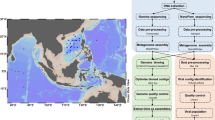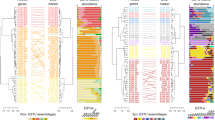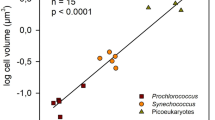Abstract
Picocyanobacteria represented by Prochlorococcus and Synechococcus have an important role in oceanic carbon fixation and nutrient cycling. In this study, we compared the community composition of picocyanobacteria from diverse marine ecosystems ranging from estuary to open oceans, tropical to polar oceans and surface to deep water, based on the sequences of 16S-23S rRNA internal transcribed spacer (ITS). A total of 1339 ITS sequences recovered from 20 samples unveiled diverse and several previously unknown clades of Prochlorococcus and Synechococcus. Six high-light (HL)-adapted Prochlorococcus clades were identified, among which clade HLVI had not been described previously. Prochlorococcus clades HLIII, HLIV and HLV, detected in the Equatorial Pacific samples, could be related to the HNLC clades recently found in the high-nutrient, low-chlorophyll (HNLC), iron-depleted tropical oceans. At least four novel Synechococcus clades (out of six clades in total) in subcluster 5.3 were found in subtropical open oceans and the South China Sea. A niche partitioning with depth was observed in the Synechococcus subcluster 5.3. Members of Synechococcus subcluster 5.2 were dominant in the high-latitude waters (northern Bering Sea and Chukchi Sea), suggesting a possible cold-adaptation of some marine Synechococcus in this subcluster. A distinct shift of the picocyanobacterial community was observed from the Bering Sea to the Chukchi Sea, which reflected the change of water temperature. Our study demonstrates that oceanic systems contain a large pool of diverse picocyanobacteria, and further suggest that new genotypes or ecotypes of picocyanobacteria will continue to emerge, as microbial consortia are explored with advanced sequencing technology.
Similar content being viewed by others
Log in or create a free account to read this content
Gain free access to this article, as well as selected content from this journal and more on nature.com
or
Accession codes
Accessions
GenBank/EMBL/DDBJ
References
Ahlgren NA, Rocap G . (2006). Culture isolation and culture-independent clone libraries reveal new ecotypes of marine Synechococcus with distinctive light and N physiologies. Appl Environ Microbiol 72: 7193–7204.
Ahlgren NA, Rocap G, Chisholm SW . (2006). Measurement of Prochlorococcus ecotypes using real-time polymerase chain reaction reveals different abundances of genotypes with similar light physiologies. Environ Microbiol 8: 441–454.
Biers EJ, Sun S, Howard EC . (2009). Prokaryotic genomes and diversity in surface ocean water: interrogating the Global Ocean Sampling metagenome. Appl Environ Microbiol 75: 2221–2229.
Brown MV, Schwalbach MS, Hewson I, Fuhrman JA . (2005). Coupling 16S-ITS rDNA clone libraries and automated ribosomal intergenic spacer analysis to show marine microbial diversity: development and application to a time series. Environ Microbiol 7: 1466–1479.
Cai H, Wang K, Huang S, Jiao N, Chen F . (2010). Distinct patterns of picocyanobacterial communities in winter and summer in the Chesapeake Bay. Appl Environ Microbiol 76: 2955–2960.
Campbell L, Nolla HA, Vaulot D . (1994). The importance of Prochlorococcus to community structure in the central north pacific-ocean. Limnol Oceanogr 39: 954–961.
Chen F, Wang K, Bachoon DS, Lu J, Lau S, Campbell L . (2004). Phylogenetic diversity of Synechococcus in the Chesapeake Bay revealed by ribulose-1,5-bisphosphate carboxylase-oxygenase (RuBisCO) large subunit gene (rbcL) sequences. Aquat Microb Ecol 36: 153–164.
Chen F, Wang K, Kan J, Suzuki MT, Wommack KE . (2006). Diverse and unique picocyanobacteria in Chesapeake Bay, revealed by 16S-23S rRNA internal transcribed spacer sequences. Appl Environ Microbiol 72: 2239–2243.
Choi DH, Noh JH . (2009). Phylogenetic diversity of Synechococcus strains isolated from the East China Sea and the East Sea. FEMS Microbiol Ecol 69: 439–448.
Coleman ML, Chisholm SW . (2007). Code and context: Prochlorococcus as a model for cross-scale biology. Trends Microbiol 15: 398–407.
Cottrell MT, Kirchman DL . (2009). Photoheterotrophic microbes in the Arctic Ocean in summer and winter. Appl Environ Microbiol 75: 4958–4966.
Dufresne A, Ostrowski M, Scanlan DJ, Garczarek L, Mazard S, Palenik BP et al. (2008). Unraveling the genomic mosaic of a ubiquitous genus of marine cyanobacteria. Genome Biol 9: R90.
Ferris MJ, Palenik B . (1998). Niche adaptation in ocean cyanobacteria. Nature 396: 226–228.
Fuller NJ, Marie D, Partensky F, Vaulot D, Post AF, Scanlan DJ . (2003). Clade-specific 16S ribosomal DNA oligonucleotides reveal the predominance of a single marine Synechococcus clade throughout a stratified water column in the Red Sea. Appl Environ Microbiol 69: 2430–2443.
Garczarek L, Dufresne A, Rousvoal S, West NJ, Mazard S, Marie D et al. (2007). High vertical and low horizontal diversity of Prochlorococcus ecotypes in the Mediterranean Sea in summer. FEMS Microbiol Ecol 60: 189–206.
Gradinger R, Lenz J . (1995). Seasonal occurance of picocyanobacteria in the Greenland Sea and central Arctic Ocean. Polar Biol 15: 447–452.
Johnson ZI, Zinser ER, Coe A, McNulty NP, Woodward EMS, Chisholm SW . (2006). Niche partitioning among Prochlorococcus ecotypes along ocean-scale environmental gradients. Science 311: 1737–1740.
Kan J, Crump B, Wang K, Chen F . (2006). Bacterioplankton community in Chesapeake Bay: predictable or random assemblages. Limnol Oceanogr 51: 2157–2169.
Kettler GC, Martiny AC, Huang K, Zucker J, Coleman ML, Rodrigue S et al. (2007). Patterns and Implications of gene gain and loss in the evolution of Prochlorococcus. PLoS Genet 3: e231.
Larkin MA, Blackshields G, Brown NP, Chenna R, McGettigan PA, McWilliam H et al. (2007). ClustalW2 and ClustalX version 2. Bioinformatics 23: 2947–2948.
Lavin P, González B, Santibáñez JF, Scanlan DJ, Ulloa O . (2010). Novel lineages of Prochlorococcus thrive within the oxygen minimum zone of the eastern tropical South Pacific. Environ Microbiol Rep 2: 728–738.
Li WKW . (1994). Primary production of prochlorophytes, cyanobacteria, and eucaryotic ultraphytoplankton: measurements from flow cytometric sorting. Limnol Oceanogr 39: 169–175.
Liu H, Nolla HA, Campbell L . (1997). Prochlorococcus growth rate and contribution to primary production in the equatorial and subtropical North Pacific Ocean. Aquat Microb Ecol 12: 39–47.
Liu H, Suzuki K, Minami C, Saino T, Watanabe M . (2002). Picoplankton community structure in the subarctic Pacific Ocean and the Bering Sea during summer 1999. Mar Ecol Progr Ser 237: 1–14.
Malmstrom RR, Coe A, Kettler GC, Martiny AC, Frias-Lopez J, Zinser ER et al. (2010). Temporal dynamics of Prochlorococcus ecotypes in the Atlantic and Pacific oceans. ISME J 4: 1252–1264.
Martiny AC, Tai AP, Veneziano D, Primeau F, Chisholm SW . (2009). Taxonomic resolution, ecotypes and the biogeography of Prochlorococcus. Environ Microbiol 11: 823–832.
Mazard S, Ostrowski M, Partensky F, Scanlan DJ . (2011). Multi-locus sequence analysis, taxonomic resolution and biogeography of marine Synechococcuse. Environ Microbiol; doi: 10: 1111/j .1462-2920.2011.02514.x.
Moore LR, Chisholm SW . (1999). Photophysiology of the marine cyanobacterium Prochlorococcus: ecotypic differences among cultured isolates. Limnol Oceanogr 44: 628–638.
Moore LR, Rocap G, Chisholm SW . (1998). Physiology and molecular phylogeny of co-existing Prochlorococcus ecotypes. Nature 393: 464–467.
Murphy LS, Haugen EM . (1985). The distribution and abundance of phototrophic ultraplankton in the North Atlantic. Limnol Oceanogr 30: 47–58.
Nubel U, Garcia-Pichel F, Muyzer G . (1997). PCR primers to amplify 16S rRNA genes from cyanobacteria. Appl Environ Microbiol 63: 3327–3332.
Olson RJ, Zettler ER, Altabet MA, Dusenberry JA, Chisholm SW . (1990a). Spatial and temporal distributions of prochlorophyte picoplankton in the North Atlantic Ocean. Deep-Sea Res I 37: 1033–1051.
Olson RJ, Zettler ER, Armbrust EV, Chisholm SW . (1990b). Pigment, size and distribution of Synechococcus in the North Atlantic and Pacific oceans. Limnol Oceanogr 35: 45–58.
Partensky F, Hess WR, Vaulot D . (1999). Prochlorococcus, a marine photosynthetic prokaryote of global significance. Microbiol Mol Biol Rev 63: 106–127.
Partensky F, Garczarek L . (2011). Prochlorococcus: advantages and limits of minimalism. Annu Rev Mar Sci 2: 305–331.
Penno S, Lindell D, Post AF . (2006). Diversity of Synechococcus and Prochlorococcus populations determined from DNA sequences of the N-regulatory gene ntcA. Environ Microbiol 8: 1200–1211.
Rocap G, Distel DL, Waterbury JB, Chisholm SW . (2002). Resolution of Prochlorococcus and Synechococcus ecotypes by using 16S-23S ribosomal DNA internal transcribed spacer sequences. Appl Environ Microbiol 68: 1180–1191.
Rocap G, Larimer FW, Lamerdin J, Malfatti S, Chain P, Ahlgren NA et al. (2003). Genome divergence in two Prochlorococcus ecotypes reflects oceanic niche differentiation. Nature 424: 1042–1047.
Rusch DB, Halpern AL, Sutton G, Heidelberg KB, Williamson S, Yooseph S et al. (2007). The sorcerer II global ocean sampling expedition: northwest Atlantic through eastern tropical Pacific. PLoS Biol 5: e77.
Rusch DB, Martiny AC, Dupont CL, Halpern AL, Venter JC . (2010). Characterization of Prochlorococcus clades from iron-depleted oceanic regions. Proc Natl Acad Sci USA 107: 16184–16189.
Saito MA, Rocap G, Moffett JW . (2005). Production of cobalt binding ligands in a Synechococcus feature at the Costa Rica upwelling dome. Limnol Oceanogr 50: 279–290.
Scanlan DJ, Ostrowski M, Mazard S, Dufresne A, Garczarek L, Hess WR et al. (2009). Ecological genomics of marine picocyanobacteria. Microbiol Mol Biol Rev 73: 249–299.
Shi Y, Tyson GW, Eppley JM, DeLong EF . (2011). Integrated metatranscriptomic and metagenomic analyses of stratified microbial assemblages in the open ocean. ISME J 5: 999–1013.
Toledo G, Palenik BP . (1997). Synechococcus diversity in the California current as seen by RNA polymerase (rpoC1) gene sequences of isolated strains. Appl Environ Microbiol 63: 4298–4303.
Toledo G, Palenik B . (2003). A Synechococcus serotype is found preferentially in surface marine waters. Limnol Oceanogr 48: 1744–1755.
Veldhuis MJW, Kraay GW, van Bleijswijk JDL, Baars MA . (1997). Seasonal and spatial variability in phytoplankton biomass, productivity and growth in the northwestern Indian Ocean: the southwest and northeast monsoon, 1992–1993. Deep-Sea Res Part I: Oceanogr Res Pap 44: 425–449.
Waleron M, Waleron K, Vincent WF, Wilmotte A . (2006). Allochthonous inputs of riverine picocyanobacteria to coastal waters in the Arctic Ocean. FEMS Microbiol Ecol 59: 356–365.
West NJ, Lebaron P, Strutton PG, Suzuki MT . (2010). A novel clade of Prochlorococcus found in high nutrient low chlorophyll waters in the South and Equatorial Pacific Ocean. ISME J 5: 933–944.
Zinser ER, Coe A, Johnson ZI, Martiny AC, Fuller NJ, Scanlan DJ et al. (2006). Prochlorococcus ecotype abundances in the North Atlantic Ocean as revealed by an improved quantitative PCR method. Appl Environ Microbiol 72: 723–732.
Zinser ER, Johnson ZI, Coe A, Karaca E, Veneziano D, Chisholm SW . (2007). Influence of light and temperature on Prochlorococcus ecotype distributions in the Atlantic Ocean. Limnol Oceanogr 52: 2205–2220.
Zwirglmaier K, Heywood JL, Chamberlain K, Woodward EMS, Zubkov MV, Scanlan DJ . (2007). Basin scale distribution patterns of picocyanobacterial lineages in the Atlantic Ocean. Environ Microbiol 9: 1278–1290.
Zwirglmaier K, Jardillier L, Ostrowski M, Mazard S, Garczarek L, Vaulot D et al. (2008). Global phylogeography of marine Synechococcus and Prochlorococcus reveals a distinct partitioning of lineages amongst oceanic biomes. Environ Microbiol 10: 147–161.
Acknowledgements
We thank Janet Rowe and Audrey Matteson for assistance in sample collection. We also thank Nyree West for exchanging information. This project was in part supported by the Xiamen University 111 program (to FC), the MOST project 2007CB815904, NSFC projects 41076063 and 40821063 and SOA project 201105021 (to NZJ), NSF Grants OCE0851113, OCE-0452409 and OCE-0825405 (to SWW) and Grant ARC-0732667 as part of the Arctic Natural Sciences Program of the National Science Foundation (to HRH).
Author information
Authors and Affiliations
Corresponding authors
Additional information
Supplementary Information accompanies the paper on The ISME Journal website
Supplementary information
Rights and permissions
About this article
Cite this article
Huang, S., Wilhelm, S., Harvey, H. et al. Novel lineages of Prochlorococcus and Synechococcus in the global oceans. ISME J 6, 285–297 (2012). https://doi.org/10.1038/ismej.2011.106
Received:
Revised:
Accepted:
Published:
Issue date:
DOI: https://doi.org/10.1038/ismej.2011.106
Keywords
This article is cited by
-
Genomic insights into cryptic cycles of microbial hydrocarbon production and degradation in contiguous freshwater and marine microbiomes
Microbiome (2023)
-
Contrasting drivers of abundant phage and prokaryotic communities revealed in diverse coastal ecosystems
ISME Communications (2023)
-
Spatio-temporal patterns of Synechococcus oligotypes in Moroccan lagoonal environments
Scientific Reports (2023)
-
Seasonal dynamics in picocyanobacterial abundance and clade composition at coastal and offshore stations in the Baltic Sea
Scientific Reports (2022)
-
Phycobilisome light-harvesting efficiency in natural populations of the marine cyanobacteria Synechococcus increases with depth
Communications Biology (2022)



